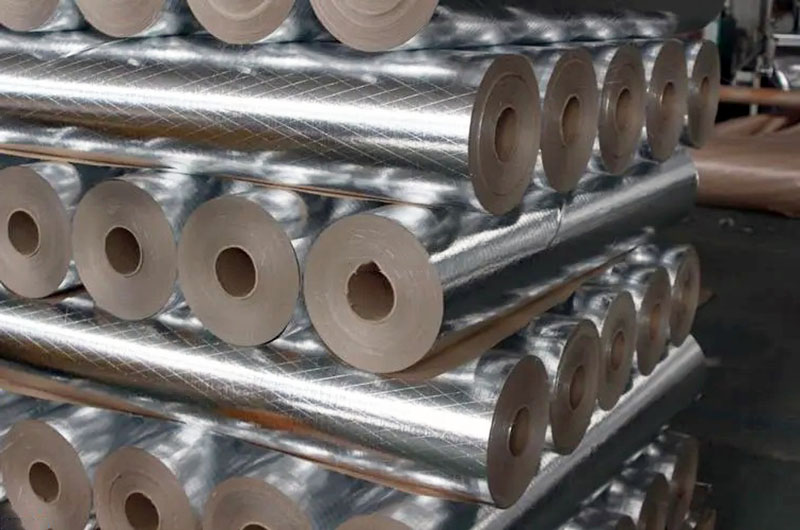

Jun. 19, 2024
The aluminum foil blank is a cold-rolled aluminum coil with a thickness of 0.4-0.7mm and a high multiple deformation rate. The aluminum foil blank is first pre-quenched at 240-480℃, and then sent to the roller press. It is rolled into sheets by rough rolling, intermediate rolling, and fine rolling with high-hardness and high-finish steel rollers, and finally formed into aluminum foil after quenching. The thickness of the aluminum foil can be controlled by adjusting the tension, the rolling force during rough rolling, and the speed during fine rolling.
During fine rolling, the thickness of the foil decreases as the rolling speed increases; the greater the tension, the smaller the thickness. The minimum thickness produced by the belt production method can reach 0.0025mm and the width can reach 1800mm. This type of aluminum foil that has not undergone other processing is called plain foil. Plain foil has poor load-bearing capacity and is rarely used alone. Generally, according to different uses, plain foil needs to be further processed to make more advanced packaging materials.

Aluminum foil usually starts with lamination, where it appears in the form of plastic film, paper or cellophane. Through a bonding process promoted by adhesives or coatings, these materials are interwoven to form a composite material with enhanced properties.
Lamination technology:
Adhesive lamination and extrusion coating are the mainstays of the lamination field, each with unique advantages. Adhesive lamination provides versatility and customization options, while extrusion coating provides seamless integration and excellent barrier properties.
Aluminum foil is laminated with plastic film, paper, cellophane, etc. with adhesives or coated with PE, etc. to form a composite film for various purposes.
The application range of composite aluminum foil is wide, from food and pharmaceutical packaging to industrial insulation. Its ability to enhance barrier properties, improve heat sealing properties and impart mechanical strength makes it indispensable in various industries.
Aluminum foil can be colored in a variety of colors on the coloring machine, with the expected metallic luster of the foil itself, forming a unique lustrous color and enhancing its decorative performance.
Aluminum Foil Coloring Technology
The artistry of aluminum foil coloring is revealed through the complex work of the coloring machine. These machines breathe life into the foil, providing a canvas for a range of vibrant tones and hues. The process requires meticulous attention to detail to ensure the consistency and quality of the final product.
In the field of colored aluminum foil, the combination of metallic luster and bright colors produces a pleasing visual spectacle. This unique luster not only adds depth to the color, but also enhances the decorative appeal of aluminum foil, making it a top choice for premium packaging.
Enhanced Decorative Performance of Aluminum Foil Coloring
In addition to its functional attributes, colored aluminum foil is an aesthetic beacon in the field of product packaging. Its ability to attract consumer attention and convey brand image through color is unparalleled.
Printing Technology
Printing on aluminum foil requires finesse and precision, as the non-absorbency of aluminum foil poses a challenge to ink adhesion. Flexographic, gravure and screen printing technologies have emerged, each with unique advantages in terms of printing quality and efficiency.
Printing Quality Assurance
Printing quality assurance involves reducing the risk of cracking, peeling, or overall separation of the ink film. Supporting thin foils during the printing process and implementing strict quality control measures are essential to ensure perfect results.
Printed aluminum foil is a powerful tool for product decoration and branding, providing endless possibilities for creativity and customization. Its ability to combine aesthetics with functionality makes it a top choice for brands that want to leave a lasting impression on consumers.
Embossed aluminum foil breathes life into aluminum foil, turning its surface into a canvas with texture and depth. Through the intricate work of the embossing machine, fascinating patterns of light and shadow appear on the foil.
Decorative and functional effects
The art of embossing is more than just decoration, it also has functional benefits such as improving surface flatness and eliminating wrinkles. Its ability to enhance the beauty of aluminum foil while improving its performance makes it a popular technology across industries.
Applications of embossed aluminum foil
Embossed aluminum foil has applications in many industries, from decorative packaging for confectionery to industrial insulation. Its versatility and aesthetic appeal make it a top choice for brands that want to add an elegant touch to their products.
Aluminium foil is a mainstay in the world of packaging and beyond, and its versatility is largely due to the myriad ways it is processed. From simple lamination to complex embossing, these techniques not only enhance its functionality but also add a touch of beauty. Whether it’s preserving freshness, grabbing attention on the shelf or adding a decorative touch.
Products you may be interested in
Users viewing this material also viewed the following
Please feel free to write down your requirement in the form below. We will reply you within 24 hours and we will protect your personal privacy information.